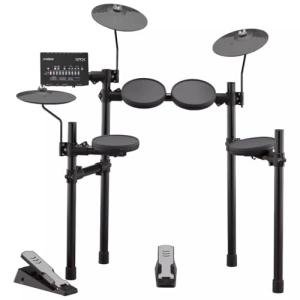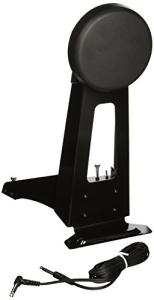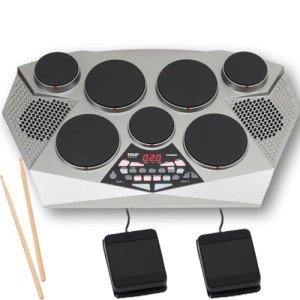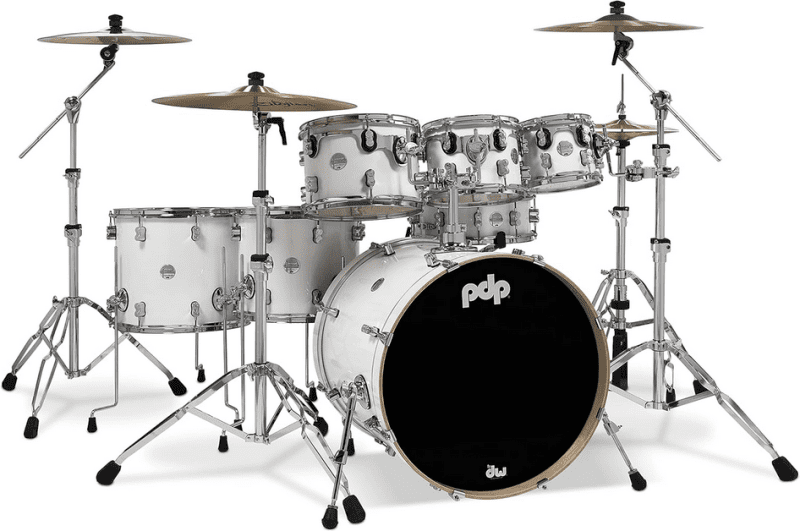Drumming is a rhythmic and musical art form that requires a great deal of skill, practice, and patience. Developing better rhythm and timing as a drummer is a crucial aspect of becoming a great musician.
It is not enough to simply play the correct notes. A drummer must also be able to keep time, stay in sync with other band members, and maintain a steady groove throughout a song.
In this article, we will explore various techniques and strategies for improving your rhythm and timing as a drummer.

Understanding rhythm and timing is the first step towards developing better skills. Rhythm refers to the pattern of beats in a song, while timing refers to the accuracy of when those beats are played.
A drummer's job is to keep time and maintain a steady beat, which is essential for the rest of the band to follow. This requires a strong sense of internal rhythm and timing, as well as the ability to listen closely to the other musicians in the group.
One of the most important tools for developing better timing as a drummer is a metronome. A metronome is a device that produces a steady, consistent beat at a set tempo.
Using a metronome during practice sessions can help drummers develop a more accurate sense of timing and stay in sync with other musicians.
In addition to using a metronome, drummers can also work on developing their internal clock and groove, as well as practicing various techniques and rhythms to improve their skills.
Key Takeaways
- Understanding rhythm and timing is crucial for developing better skills as a drummer.
- Using a metronome during practice sessions can help improve timing and stay in sync with other musicians.
- Developing an internal clock and groove, practicing various techniques and rhythms, and playing with others are all important strategies for improving rhythm and timing.
Understanding Rhythm and Timing
The Role of Timekeeping in Music
Timekeeping is an essential part of music. It is the backbone of a song, and it helps to keep all the musicians in sync.
The drummer is usually responsible for keeping time, but all the other musicians need to be aware of the beat and tempo as well.
Good timekeeping is crucial for a cohesive and enjoyable musical performance.
Counting and Subdivisions
Counting is a fundamental aspect of timekeeping. It helps musicians to stay on beat and keep track of the rhythm.
Musicians count the beats in a measure, which is determined by the time signature.
The time signature is a fraction-like symbol that appears at the beginning of a piece of music and tells the musician how many beats are in a measure and what kind of note gets the beat.
Subdivisions are equally important when it comes to timekeeping. They are the smaller divisions of the beat that help musicians to stay on track.
For example, if a song is in 4/4 time, there are four beats in each measure, and each beat can be subdivided into two or four smaller beats.
Subdivisions help musicians to stay on time and keep the rhythm flowing smoothly.
Time Signature Fundamentals
The time signature is a crucial aspect of understanding rhythm and timing. It tells musicians how many beats are in a measure and what kind of note gets the beat.
For example, a time signature of 4/4 means that there are four beats in each measure, and a quarter note gets the beat. A time signature of 3/4 means that there are three beats in each measure, and a quarter note gets the beat.
Understanding time signatures is essential for good timekeeping. It helps musicians to stay on beat and keep track of the rhythm.
So, musicians need to be aware of the time signature and count the beats in each measure to stay on time.
The Importance of a Metronome
Drumming is all about rhythm and timing, and a metronome is an essential tool that can help drummers develop a strong sense of both.
A metronome provides a steady click or beat that acts as a reliable timekeeper during practice sessions and performances.
In this section, we will discuss the importance of a metronome and how to use it effectively to improve your drumming skills.
How to Practice with a Metronome
Practicing with a metronome is one of the most effective ways to improve your rhythm and timing as a drummer.
Start by selecting a piece of music you want to learn and identify the shortest note value, such as eighth or sixteenth notes.
Then, set your metronome to a comfortable tempo, usually around 60 beats per minute (BPM), and practice the passage with the shortest note value equal to the BPM.
As you become more comfortable with the passage, gradually increase the tempo of the metronome by a few BPM.
Keep practicing at the new tempo until you feel comfortable, and then increase the tempo again. Repeat this process until you can play the passage at the desired tempo with ease.
Choosing the Right Metronome
Choosing the right metronome is essential for effective practice.
There are various types of metronomes available, including traditional mechanical metronomes, digital metronomes, and metronome apps.
Mechanical metronomes are the most traditional and produce an audible click sound. Digital metronomes are more versatile and offer a range of features such as different sounds, rhythms, and time signatures.
Metronome apps are also popular and offer the advantage of portability and convenience.
When choosing a metronome, consider the features that are important to you, such as the ability to set different time signatures, rhythms, and tempos.
Also, consider the sound quality and volume of the metronome, as well as its portability and ease of use.
Developing Internal Clock and Groove

Exercises for Internal Timing
Developing a strong internal clock is crucial for any musician, especially for drummers. It helps to keep the rhythm steady and consistent, and allows for more complex and interesting patterns to be played.
One exercise to improve internal timing is to practice playing along with a metronome.
Start by setting the metronome to a slow tempo and play simple rhythms along with it.
Gradually increase the tempo and complexity of the rhythms as you become more comfortable.
Another exercise is to practice playing with a drum machine or loop. This helps to develop a strong sense of groove and allows for more creativity in playing.
Try experimenting with different styles and tempos to challenge yourself and improve your timing.
Playing with Feeling vs. Precision
While precision is important for maintaining a steady rhythm, it's also important to play with feeling and groove.
One way to develop this is to practice playing along with recordings of your favorite drummers.
Pay attention to the nuances and variations in their playing and try to incorporate them into your own playing.
Confidence is also key when it comes to playing with feeling and groove.
Don't be afraid to experiment and take risks in your playing. Trust in your own abilities and let your instincts guide you.
Techniques for Better Timing

Limb Independence and Coordination
One of the most important techniques for developing better timing as a drummer is to work on limb independence and coordination.
This means being able to play different rhythms with each limb simultaneously. When a drummer has good limb independence, they can play complex rhythms with ease and precision.
To develop limb independence, drummers can practice exercises that focus on playing different rhythms with each limb.
For example, they can practice playing a snare drum pattern with their left hand while playing a bass drum pattern with their right foot. This helps build muscle memory and coordination between the limbs.
Dynamic Control in Drumming
Another important technique for developing better timing as a drummer is to work on dynamic control.
This means being able to play with different levels of volume and intensity while maintaining a steady tempo.
To develop dynamic control, drummers can practice playing with a metronome at different volume levels.
They can also practice playing with different levels of intensity, such as playing a soft beat and gradually increasing the volume over time. This helps build muscle memory and control over the drumsticks, allowing the drummer to play with precision and accuracy.
Practical Application and Practice
Playing Along with Songs and Tracks
One of the most effective ways to develop better rhythm and timing as a drummer is to play along with songs and tracks.
This allows drummers to practice their drumming skills while also developing their sense of timing and rhythm.
When playing along with songs and tracks, drummers should focus on playing the drum beats accurately and in time with the music.
They should also pay attention to the dynamics of the music and adjust their playing accordingly.
To make the most out of this practice method, drummers should choose songs and tracks that match their skill level.
They should start with simpler songs and gradually move on to more complex ones.
Drummers can also use a metronome or drum machine to help them stay in time with the music.
Recording Yourself for Improvement
Recording oneself while playing the drums is another effective way to develop better rhythm and timing.
This allows drummers to listen back to their playing and identify areas where they need to improve.
When recording oneself, drummers should use a high-quality microphone and recording software to capture the best possible sound.
After recording, drummers should listen back to their playing and identify areas where they need to improve.
They should pay attention to their timing, dynamics, and overall playing style.
They can also ask for feedback from other musicians or drum teachers to help them identify areas for improvement.
In addition to identifying areas for improvement, drummers can also use recordings to track their progress over time.
By listening back to previous recordings, drummers can see how much they have improved and identify areas where they still need to work.
This can be a great motivator and help drummers stay on track with their practice sessions.
Advanced Rhythmic Concepts
As a drummer, mastering advanced rhythmic concepts can take your skills to the next level.
Two important concepts to focus on are polyrhythms and odd time signatures, as well as incorporating rudiments into beats and fills.
Polyrhythms and Odd Time Signatures
Polyrhythms involve playing two or more rhythms simultaneously, often with different time signatures. This can add complexity and interest to your playing.
One way to practice polyrhythms is to start with simple combinations, such as playing triplets over a straight beat.
From there, you can experiment with more complex combinations, such as playing a 5/4 time signature over a 4/4 beat.
Odd time signatures, such as 5/4 or 7/8, can also add interest to your playing. To practice odd time signatures, start by counting the beats and subdividing them.
For example, in 5/4 time, you can count "1-2-3-4-5" and subdivide each beat into triplets. This will help you feel the rhythm and play it accurately.
Incorporating Rudiments into Beats and Fills
Rudiments are the building blocks of drumming, and incorporating them into your beats and fills can add complexity and interest.
For example, you can use a paradiddle to create a unique fill, or incorporate a flam into a beat for added texture.
To practice incorporating rudiments, start with simple beats and fills and gradually add in more complex patterns.
Practice slowly at first, focusing on accuracy and timing. As you become more comfortable, you can increase the tempo and experiment with different combinations.
Playing with Others
Playing with other musicians is an essential part of developing better rhythm and timing as a drummer. It helps you to synchronize with other band members and adapt to different musical styles.
Synchronization with Band Members
To synchronize with other band members, you need to listen carefully to what they are playing. This will help you to understand their rhythms and timing and allow you to play in sync with them.
You also need to communicate with other musicians and discuss the tempo and feel of the music.
In a rock band, the drummer needs to work closely with the bassist to create a tight rhythm section.
In hip-hop and Latin music, the drummer needs to work with the percussionist to create a groove. In blues and funk music, the drummer needs to work with the guitarist and keyboardist to create a tight rhythm section.
Adapting to Different Musical Styles
Adapting to different musical styles is also important when playing with other musicians. Each musical style has its own unique rhythm and timing, and it's important to be able to adapt to these styles.
For example, in rock music, the drummer needs to play with a strong backbeat and keep the tempo steady.
In hip-hop music, the drummer needs to create a groove with the bass and percussion. In Latin music, the drummer needs to play with a strong sense of rhythm and timing. In blues and funk music, the drummer needs to play with a tight rhythm section and create a groove with the other musicians.
 Performance and Stage Presence
Performance and Stage Presence
Managing Tempo Live
When performing live, managing tempo is crucial for a successful performance. It is the drummer's responsibility to keep the band in time and on tempo.
One way to manage tempo live is to use a metronome or click track. However, relying too much on a metronome can lead to dependency and make it challenging to keep time without it.
Therefore, it is essential to practice without a metronome to develop internal timing and feel.
Another way to manage tempo live is to communicate with the other musicians on stage.
This can be done through eye contact, physical cues, or verbal communication.
You need to establish a strong connection with the bass player to anchor the rhythm section and establish a tight groove.
Engaging the Audience with Solid Timekeeping
Solid timekeeping is crucial for engaging the audience during a live performance. The drummer's role is not only to keep the band in time but also to provide a solid foundation for the rest of the band to build upon.
To engage the audience, the drummer should focus on playing with confidence and groove.
One way to achieve solid timekeeping is to practice with a metronome. This will help to develop precision and timing accuracy.
Another way is to practice playing along with recordings and focusing on matching the feel and groove of the original recording.
In addition to playing with confidence and groove, the drummer should also be aware of their body language and stage presence.
Engaging the audience with eye contact, smiles, and physical movements can enhance the performance and create a connection with the audience.
Technology and Drumming
Using Click Tracks and Drum Machines
Click tracks and drum machines are powerful tools for drummers to develop better rhythm and timing.
A click track is a metronome that plays a steady beat, helping drummers to stay in time. It is often used in recording studios to ensure that all musicians are playing in sync with each other.
A drum machine, on the other hand, is a device that can produce drum sounds and rhythms.
It can be programmed to play a specific beat or rhythm and can be used for practice or performance.
Both click tracks and drum machines can be used in a variety of ways to improve a drummer's timing.
For example, a drummer can play along with a click track or drum machine to practice staying in time.
They can also use these tools to practice playing different rhythms and time signatures.
In addition, click tracks and drum machines can be used to create backing tracks for performances. This allows drummers to play along with a pre-recorded rhythm section.
Electronic Drum Kits for Practice
Electronic drum kits are another useful tool for drummers looking to develop their rhythm and timing.
These kits are designed to simulate the feel and sound of an acoustic drum set, but with the added benefit of being able to play with headphones.
This allows drummers to practice without disturbing others and also provides the ability to adjust the volume and sound of the drums.
Electronic drum kits can also be used to practice with click tracks and drum machines.
Many electronic drum kits have built-in metronomes and drum machine sounds, making it easy to practice different rhythms and time signatures.
In addition, electronic drum kits can be connected to computers and other devices. This allows drummers to record their practice sessions and analyze their playing.
Setting Goals and Tracking Progress
As a drummer, setting goals and tracking progress is essential to developing better rhythm and timing. This section outlines some tips for setting goals and tracking progress.
Short-Term and Long-Term Goals
Professional drummers set both short-term and long-term goals to help them achieve their desired level of drumming skills.
Short-term goals are easier to achieve and can be accomplished within a few weeks or months. Long-term goals are more challenging and require more time and effort to achieve.
To set effective goals, drummers should write them down and make them specific, measurable, achievable, relevant, and time-bound.
For example, a short-term goal could be to learn a new drumming pattern within two weeks, while a long-term goal could be to perform in a live concert within six months.
Assessing Your Development as a Drummer
Regularly assessing your development as a drummer is crucial to tracking progress and achieving your goals.
Drummers can use different methods to assess their development, such as recording their practice sessions, asking for feedback from other musicians, or working with a drumming coach.
To track progress, drummers should create a practice log or use a drumming app.
These tools allow them to track their practice time, the exercises they have worked on, and their progress.
For example, the Melodics app provides drummers with a progress report that shows their accuracy, speed, and consistency over time.
Frequently Asked Questions
What exercises can improve my timing on the drum set?
Many exercises can improve the timing of the drum set.
One simple exercise is to play along with a metronome, starting at a slow tempo and gradually increasing the speed.
Another exercise is to practice playing along with recordings of songs, paying close attention to the tempo and rhythm of the music.
Additionally, practicing rudiments and other technical exercises can help to develop muscle memory and improve timing.
Are there any effective apps or tools for practicing drum timing?
Yes, there are many apps and tools available that can help with practicing drum timing.
Some popular options include metronome apps, drum machine apps, and rhythm training apps.
It's important to choose an app or tool that is easy to use and provides accurate timing feedback.
What techniques do professional drummers use to maintain consistent rhythm?
Professional drummers use a variety of techniques to maintain a consistent rhythm. They practice with a metronome, play along with recordings, and focus on their internal sense of timing. They also pay close attention to their physical technique, ensuring that their strokes are consistent and even.
How can I incorporate a metronome into my drum practice for better timing?
Incorporating a metronome into your drum practice is a great way to improve timing. Start by setting the metronome to a slow tempo and playing along with it. Focus on staying in time with the clicks. As you get more comfortable, gradually increase the tempo. You can also experiment with different subdivisions and accents to develop your sense of rhythm.
In what ways does playing drums regularly enhance one's sense of rhythm?
Playing drums regularly can enhance one's sense of rhythm in many ways. It helps to develop muscle memory and improve timing, as well as increase sensitivity to different rhythms and subdivisions. Additionally, playing with other musicians can help to develop a sense of groove and improve overall musicality.
What strategies can I use to improve the dynamics and control in my drumming?
To improve dynamics and control in drumming, focus on technique and practice regularly.
Start by practicing basic strokes and rudiments at a slow tempo. Then, gradually increase the speed as you improve.
Experiment with different dynamics, focusing on playing with a consistent sound and volume.
Additionally, practicing with a metronome can help to improve control and precision in your playing.







